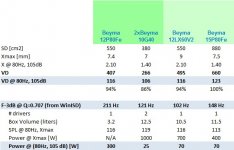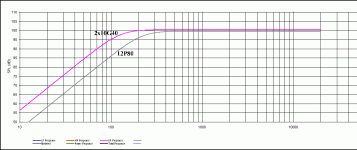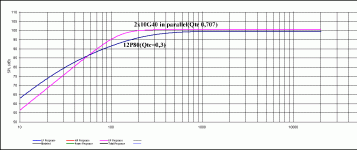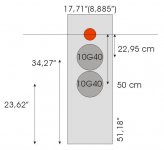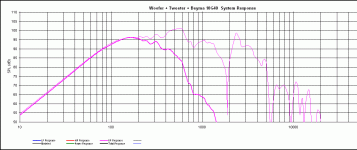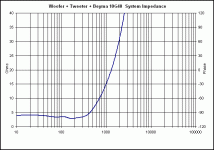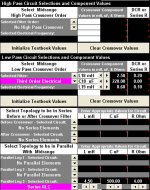I'm going through the driver selection for 80 to 400 Hz in a 4-way active system. My goal is to achieve top dynamics and texture/detail. My listening levels typically are 85dB C-weighted, and sometimes 90dB.
I realize size of the driver matters. But driver size seems to tell part of the story. Example with Beyma drivers: 10G40, 12P80Fe, 12LX60V2, 15P80Fe. Please see the attachment.
Twin 10G40 have more Sd than the 12" drivers, but if I look at driver displacement at 80Hz and 105dB, the Vd of either 12"-driver is higher than that of the twin 10G40. The 15P80Fe has higher Sd and Vd than the other options. A 15" midbass seems like overkill, though, in light of my 12" subwoofers...
I'm probably overthinking this! 😱
BTW, what role does suspension compliance play here? Higher compliance means less force needs to be applied to achieve a given displacement. Considering my listening levels, should I favor higher compliances?
I realize size of the driver matters. But driver size seems to tell part of the story. Example with Beyma drivers: 10G40, 12P80Fe, 12LX60V2, 15P80Fe. Please see the attachment.
Twin 10G40 have more Sd than the 12" drivers, but if I look at driver displacement at 80Hz and 105dB, the Vd of either 12"-driver is higher than that of the twin 10G40. The 15P80Fe has higher Sd and Vd than the other options. A 15" midbass seems like overkill, though, in light of my 12" subwoofers...
I'm probably overthinking this! 😱
BTW, what role does suspension compliance play here? Higher compliance means less force needs to be applied to achieve a given displacement. Considering my listening levels, should I favor higher compliances?
Attachments
I'm going through the driver selection for 80 to 400 Hz in a 4-way active system. My goal is to achieve top dynamics and texture/detail. My listening levels typically are 85dB C-weighted, and sometimes 90dB.
I realize size of the driver matters. But driver size seems to tell part of the story. Example with Beyma drivers: 10G40, 12P80Fe, 12LX60V2, 15P80Fe. Please see the attachment.
Twin 10G40 have more Sd than the 12" drivers, but if I look at driver displacement at 80Hz and 105dB, the Vd of either 12"-driver is higher than that of the twin 10G40. The 15P80Fe has higher Sd and Vd than the other options. A 15" midbass seems like overkill, though, in light of my 12" subwoofers...
I'm probably overthinking this! 😱
BTW, what role does suspension compliance play here? Higher compliance means less force needs to be applied to achieve a given displacement. Considering my listening levels, should I favor higher compliances?
10G40 is 266 EACH, 532 for a pair.
Hi,
didn't You realize that the volume values are totall off?
Assuming that You add a dedicated woofer the midbass driver could best be mounted in a closed cabinet.
There are 3 very easy to calculate formulas that allow You to basically evaluate the useability of the drivers.
- choose the Fb, the resonance of the built-in driver.
- calculate Fb/Fs=X
- calculate Qtb, the built-in Quality factor. Qtb=Qts*X
- calculate the required Volume Vb from Vb=Vas/(X^2 - 1)
Say You choose X=2. Then for the 10BG40 with Fs=45Hz, Qts=0.3 and Vas=49L
Fb=90Hz, Qtb=0.6 and Vb=~18L. (beware of different parameters between DS and short-catalogue values!)
The 12LX60V2 seems also suitable for Your requirements.
You can of course also start from a chosen Qtb, calculating X and from that calculating Fb and Vb.
Qtb is preferrably chosen between 0.7 and 1.0.
jauu
Calvin
didn't You realize that the volume values are totall off?
Assuming that You add a dedicated woofer the midbass driver could best be mounted in a closed cabinet.
There are 3 very easy to calculate formulas that allow You to basically evaluate the useability of the drivers.
- choose the Fb, the resonance of the built-in driver.
- calculate Fb/Fs=X
- calculate Qtb, the built-in Quality factor. Qtb=Qts*X
- calculate the required Volume Vb from Vb=Vas/(X^2 - 1)
Say You choose X=2. Then for the 10BG40 with Fs=45Hz, Qts=0.3 and Vas=49L
Fb=90Hz, Qtb=0.6 and Vb=~18L. (beware of different parameters between DS and short-catalogue values!)
The 12LX60V2 seems also suitable for Your requirements.
You can of course also start from a chosen Qtb, calculating X and from that calculating Fb and Vb.
Qtb is preferrably chosen between 0.7 and 1.0.
jauu
Calvin
Last edited:
10G40 is 266 EACH, 532 for a pair.
Not sure which website you are checking, but at US Speaker they are $200 each.
Nevertheless, I realize two 10" drivers will cost more than one 12". Baffle diffraction simulation suggests two 10" can have a better response than one 12", though, so it would be a price-to-performance tradeoff. What I'm after with this thread is making sure I fully understand the "performance" piece of the equation before I factor in price.
cheers
Hi,
didn't You realize that the volume values are totall off?
Of course not. I wouldn't have posted wrong figures purposefully.
How are they off?
Correct; that is my plan.Assuming that You add a dedicated woofer the midbass driver could best be mounted in a closed cabinet.
How do I decide what value to choose for X? In a sealed box with Qtc=0.707, Fb=122 so X=2.7...whatever that means.There are 3 very easy to calculate formulas that allow You to basically evaluate the useability of the drivers.
- choose the Fb, the resonance of the built-in driver.
- calculate Fb/Fs=X
- calculate Qtb, the built-in Quality factor. Qtb=Qts*X
- calculate the required Volume Vb from Vb=Vas/(X^2 - 1)
Say You choose X=2. Then for the 10BG40 with Fs=45Hz, Qts=0.3 and Vas=49L
Fb=90Hz, Qtb=0.6 and Vb=~18L. (beware of different parameters between DS and short-catalogue values!)
The 12LX60V2 seems also suitable for Your requirements.
You can of course also start from a chosen Qtb, calculating X and from that calculating Fb and Vb.
Qtb is preferrably chosen between 0.7 and 1.0.
jauu
Calvin
You have explained a procedure, but not the criteria for the selection. Would you elaborate?
The 12LX60V2 is also within the short list. Seems better suited as a subwoofer than a midbass, though.
As I understand it, big size is ONLY used to increase sensitivity.
If you don't need the high sensitivity brought about by the big size, then your second selection criteria is upper wave length limit to prevent excessively narrow beaming at the crossover frequency.
For 400Hz, I suggest that 15" is too big.
12" is probably OK, if the cone is well behaved, but 10" may be the more easily EQed size for 400Hz.
If you wanted 120Hz to 400Hz, then I would go right down to an 8" driver.
The quarter wavelength of 400Hz is ~210mm
If you don't need the high sensitivity brought about by the big size, then your second selection criteria is upper wave length limit to prevent excessively narrow beaming at the crossover frequency.
For 400Hz, I suggest that 15" is too big.
12" is probably OK, if the cone is well behaved, but 10" may be the more easily EQed size for 400Hz.
If you wanted 120Hz to 400Hz, then I would go right down to an 8" driver.
The quarter wavelength of 400Hz is ~210mm
Twin 10G40 have more Sd than the 12" drivers, but if I look at driver
displacement at 80Hz and 105dB, the Vd of either 12"-driver is higher
than that of the twin 10G40.
Of course a single 12" driver has to travel more of Xmax to output 105dB,
than 2 10" drivers in parallel. The Vd calculation of 10G40 is correct for one
driver ( 380cm^2*0,7cm=266cm^3). Try to simulate the response of a driver
in the box crossed over to other units of the 4 way speaker.
As I understand it, big size is ONLY used to increase sensitivity.
If you don't need the high sensitivity brought about by the big size, then your second selection criteria is upper wave length limit to prevent excessively narrow beaming at the crossover frequency.
For 400Hz, I suggest that 15" is too big.
12" is probably OK, if the cone is well behaved, but 10" may be the more easily EQed size for 400Hz.
If you wanted 120Hz to 400Hz, then I would go right down to an 8" driver.
The quarter wavelength of 400Hz is ~210mm
thank you Andrew. I was under the impression size was connected with the "sense of impact", dynamics, and the feeling of listening to a large speaker.
120Hz is too high for my subs. Maybe even 80Hz is 10Hz too high, but measurements for the subs suggest I should be ok.
But yes, I'm down to one 12" vs two 10".
i choosed this and believe it can do 400-500hz
210 15NMB420 - LF Transducers - Neodymium 15NMB420 : Eighteen Sound - professional loudspeakers
210 15NMB420 - LF Transducers - Neodymium 15NMB420 : Eighteen Sound - professional loudspeakers
Of course a single 12" driver has to travel more of Xmax to output 105dB,
than 2 10" drivers in parallel. The Vd calculation of 10G40 is correct for one
driver ( 380cm^2*0,7cm=266cm^3). Try to simulate the response of a driver
in the box crossed over to other units of the 4 way speaker.
Hey Lojzek! I've been going through the links you provided to resources in a previous post of mine. I'm likely to come back with more questions 😀 but first I want to do my homework.
You are right: the Vd calculation for the two 10G40 is wrong. But I'm not really using that one, but rather the "Vd @ 80Hz, 105dB" and I believe that one is correct for the 1 vs 2 10G40.
I'm looking into simulating the response to the other units in the speaker. I'm working with Bagby's Woofer Box Model now as it has "textbook" hi/lo pass filters built in. UniBox requires me to input the electrical values which I don't know.
Nevertheless, how will doing this help me in deciding between these woofers?
Hi,
strictly taken, all four of the drivers You named are not really sufficient to reach down to 80Hz linearly unequalized.
You probabely need to EQ with a little boost around 80-90Hz.
For a driver that could go linear down below 80Hz, You'd rather find a 12" or 10" with lower efficiency of around 92-94dB instead 96dB.
jauu
Calvin
strictly taken, all four of the drivers You named are not really sufficient to reach down to 80Hz linearly unequalized.
You probabely need to EQ with a little boost around 80-90Hz.
For a driver that could go linear down below 80Hz, You'd rather find a 12" or 10" with lower efficiency of around 92-94dB instead 96dB.
jauu
Calvin
theory verses the real world
I just went through almost a "shocking" reminder of what I should have already known. Matter of fact, I used to preach this repeatedly back in my younger days.
TEST YOUR DRIVERS FIRST, yes, in a TEST BOX.
Get yourself some T/S testing device, such as that sold by parts express, and find your Thiel/Small parameters, and ALSO test frequency response in a test box volume similar to what you might be using in your final installation.
Also, while I am on my rampage, I have found that as a driver reaches a much higher efficiency that a standard "hi-fi" woofer, one is not as constricted to what the T/S parameters dictate for the predicted low frequency limit.
In the case of a Beyma 10G40, I would try in mounted securely in a one cubic foot box and test for all parameters including the low frequency limit.
In certainly does help if your vendor offers a money-back policy for items not meeting your intended use. Just don't solder the terminals.
I just went through almost a "shocking" reminder of what I should have already known. Matter of fact, I used to preach this repeatedly back in my younger days.
TEST YOUR DRIVERS FIRST, yes, in a TEST BOX.
Get yourself some T/S testing device, such as that sold by parts express, and find your Thiel/Small parameters, and ALSO test frequency response in a test box volume similar to what you might be using in your final installation.
Also, while I am on my rampage, I have found that as a driver reaches a much higher efficiency that a standard "hi-fi" woofer, one is not as constricted to what the T/S parameters dictate for the predicted low frequency limit.
In the case of a Beyma 10G40, I would try in mounted securely in a one cubic foot box and test for all parameters including the low frequency limit.
In certainly does help if your vendor offers a money-back policy for items not meeting your intended use. Just don't solder the terminals.
Hi,
strictly taken, all four of the drivers You named are not really sufficient to reach down to 80Hz linearly unequalized.
You probabely need to EQ with a little boost around 80-90Hz.
For a driver that could go linear down below 80Hz, You'd rather find a 12" or 10" with lower efficiency of around 92-94dB instead 96dB.
jauu
Calvin
Why do you say so? I've simulated all of these in UniBox and they indeed get to 80Hz at 105dB in a sealed box, with the power shown there. What am I missing?
FWIW, I will use digital active XO with DRC. But I doubt that is very important in the context of this thread.
I just went through almost a "shocking" reminder of what I should have already known. Matter of fact, I used to preach this repeatedly back in my younger days.
TEST YOUR DRIVERS FIRST, yes, in a TEST BOX.
Get yourself some T/S testing device, such as that sold by parts express, and find your Thiel/Small parameters, and ALSO test frequency response in a test box volume similar to what you might be using in your final installation.
Also, while I am on my rampage, I have found that as a driver reaches a much higher efficiency that a standard "hi-fi" woofer, one is not as constricted to what the T/S parameters dictate for the predicted low frequency limit.
In the case of a Beyma 10G40, I would try in mounted securely in a one cubic foot box and test for all parameters including the low frequency limit.
In certainly does help if your vendor offers a money-back policy for items not meeting your intended use. Just don't solder the terminals.
Hey Scott.
I know you are right. I don't know if the vendor will allow this, though. I can try. But I should probably narrow it down to two options and propose that to the vendor.
Still need to derive a point of view, though 🙁
...and I believe that one is correct for the 1 vs 2 10G40.
Nevertheless, how will doing this help me in deciding between these woofers?
Howdy Lewinski,
That one is correct, 380*2*0,14=106,4
The first graph depicts two boxes with the same Qtc od 0,707.
10 dB of difference at 80Hz for the same input voltage. The second
graph is when you change the Qtc of a single 12P80 to 0,3.
Attachments
post16 shows me that the Butterworth roll-off is @ ~120Hz
That requires that the Bass only speaker should also roll off at the same 120Hz.
80Hz is the wrong frequency for the bass only.
That requires that the Bass only speaker should also roll off at the same 120Hz.
80Hz is the wrong frequency for the bass only.
Hey Lewinski,
this is one way of deriving a point of view for comparison purposes.
The simulation is based on the baffle dimensions as shown, cabinet
volume of 12,5 litres for each unit ( parallel) with Qtc of 0,7. The
passive parts section you won't need. Try to do the same for the other
configuration types. Woofer roll-off is simulated and pasted to
manufacturer's measurement with the addition of baffle diffraction.
Mind you, there is no HP filter.
this is one way of deriving a point of view for comparison purposes.
The simulation is based on the baffle dimensions as shown, cabinet
volume of 12,5 litres for each unit ( parallel) with Qtc of 0,7. The
passive parts section you won't need. Try to do the same for the other
configuration types. Woofer roll-off is simulated and pasted to
manufacturer's measurement with the addition of baffle diffraction.
Mind you, there is no HP filter.
Attachments
post16 shows me that the Butterworth roll-off is @ ~120Hz
That requires that the Bass only speaker should also roll off at the same 120Hz.
80Hz is the wrong frequency for the bass only.
I guess by "Butterworth roll-off" you mean F-3dB when used in a box with Qtc=0.707, right? If so, sure, I included that info on my initial table and indeed the two 10G40 have an F3 of 121Hz vs 12P80Fe of 211Hz, 12LX60V2 of 102Hz, and 15P80Fe of 148Hz. I've included the table again for user friendliness. From this point of view the 12LX60V2 looks better, but this one looks more like a subwoofer driver and I'm afraid it might be too "slow" going up to 400Hz.
I can't cross my subwoofers at 120Hz; maybe I could go up to 90hz, but no further.
Attachments
Hey Lewinski,
this is one way of deriving a point of view for comparison purposes.
The simulation is based on the baffle dimensions as shown, cabinet
volume of 12,5 litres for each unit ( parallel) with Qtc of 0,7. The
passive parts section you won't need. Try to do the same for the other
configuration types. Woofer roll-off is simulated and pasted to
manufacturer's measurement with the addition of baffle diffraction.
Mind you, there is no HP filter.
Thank you for doing that! What simulator are you using? Looks like Bagby's aesthethics, but it's not the Diffraction nor the Woofer Model simulators - I don't think.
Will study this and come back.
BTW, simulating baffle step, boundaey reinforcement, etc with Bagby's model showed that using two drivers (2x10G40) allowed for placement alternatives that minimized losses at least better than having just one such driver.
- Status
- Not open for further replies.
- Home
- Loudspeakers
- Multi-Way
- In midbass size matters. But which size matters?
